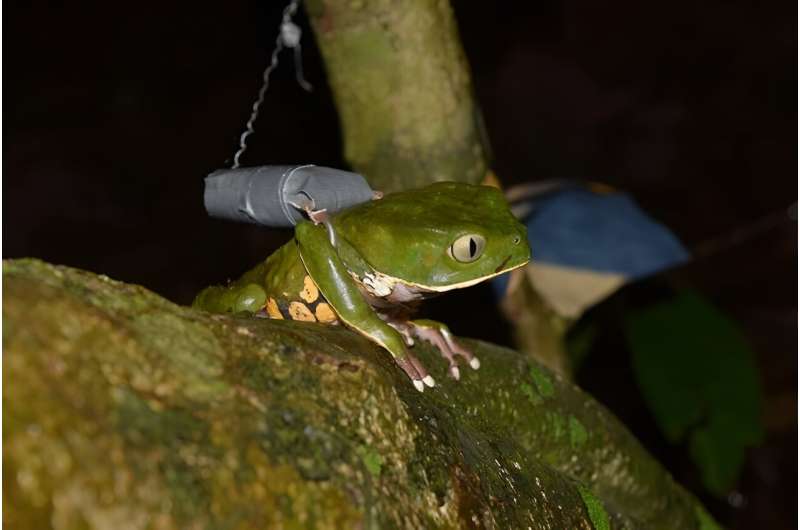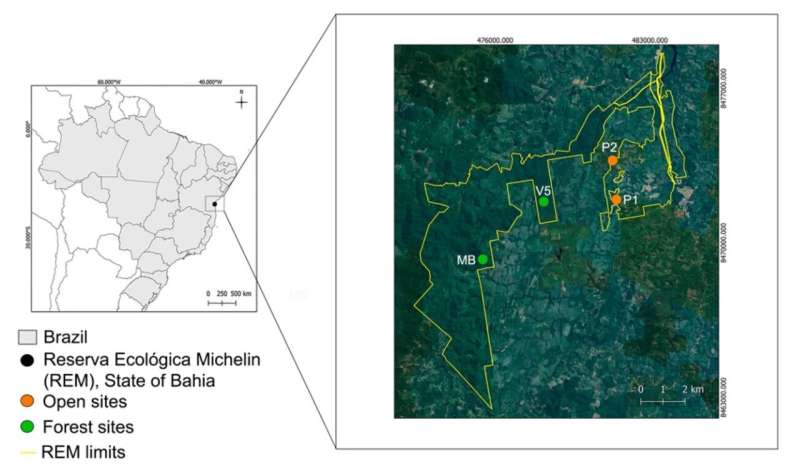October 9, 2023 feature
This article has been reviewed according to Science X's editorial process and policies. Editors have highlighted the following attributes while ensuring the content's credibility:
fact-checked
peer-reviewed publication
trusted source
proofread
New study on movement patterns of leaf frogs in Brazil could open a path for conservation strategies

For researchers and environmentalists, knowing how frogs and other amphibians move through their environment is an important part of the ability to appropriately target conservation efforts. Movement is a crucial part of the relationship a species has with its environment, and disruptions in amphibian environments can take a toll on populations.
Seeking to address a gap in data on movement behavior of the nocturnal tree frog Phyllomedusa burmeisteri, also known as Burmeister's leaf frog, a research team from Brazil's Universidade Estadual de Santa Cruz and Germany's Zoologisches Forschungsmuseum Alexander Koenig have studied 19 of the frogs within the Reserva Ecologica Michelin, which includes rain forest and open areas, in Brazil's Bahia region.
Their findings, titled "Following the footsteps of Burmeister's leaf frog (Phyllomedusa burmeisteri) in the Atlantic forest of Brazil," are described in Scientific Reports.
Burmeister's leaf frogs begin their lives as tadpoles in ponds, and move onto land in the juvenile phase of their lives. Rather than jumping, they use their legs to walk slowly, and often cling to surfaces such as tree branches.
Key drivers of movement in this species are the availability and reliability of resources, as well as the structure of the landscape. Understanding the movement behaviors of these frogs can help shed light on many aspects of their existence, including their home range, population densities, patterns of migration, and where they reproduce.

Collecting the data
Within this study, the researchers sought to estimate the frogs' movement distances within periods of one and four days, as well as understand their general movement patterns. They also aimed to determine any potential correlation between the frogs' weight and their movement, and to compare the movement patterns of frogs from ponds within the forest (eight males and two females) to those from ponds outside it (eight males, one female).
To track the frogs' movements, the team fitted each of the study subjects with a backpack-type spool-and-line device consisting of a bobbin wound with approximately 250 meters of line. None of the tracking devices weighed more than 10% of the weight of the frog to which it was attached.
Over a four-day period, the team monitored each frog once a day by following its thread, checking the frogs for injuries and replacing bobbins as needed so that none of the thread ran out. For frogs within and outside the forest, the researchers noted distances traveled, maximum heights attained, and the frogs' behavior during their observations.
Findings
The team observed that the tracking devices did not impede the frogs' normal activity. The frogs walked, climbed trees, and moved through water with ease.
While the mean total movement difference in distances traveled did not differ significantly between those in the forest and those in open areas, frogs in the forest reached greater heights than those in open areas, and the average of total steps taken by those in open areas was slightly more than that of their forest counterparts.
All the study subjects fluctuated haphazardly between moving horizontally and moving vertically, and similar fluctuations were seen in distances traveled between directional changes, and in the frogs' daily activity patterns.
Frogs from open areas moved less frequently to the east but more frequently to the north, west, and south; ponds in those areas were located to the west. Those from the forest, where ponds were located to the south, moved less frequently in a northerly direction but more frequently west, south, and east.
The researchers report a positive relationship between the frogs' weight and the distances they moved. Notably, the heaviest frog (40.77 g) moved the greatest distance (4,824 cm), while another frog approximately half its size (20.5 g) covered nearly the same distance (4,700 cm).

Why is this important?
This research expands on existing work on movement behavior of frogs in Brazil, much of which has been based on estimates of linear distance. Through actual data, including details of turning angles, this study shows that P. burmeisteri may move more slowly and carefully than other tree frogs, but that they cover comparable daily distances.
In addition, the paper states, "Even though this species is mostly found in tree branches, it also uses microhabitats such as low vegetation (herbs and logs), as well as medium and higher vegetation and aquatic environments."
This may be significant with regard to reproduction in this species, according to the researchers, "...our individuals of open areas preferred lower vegetation, and were frequently recorded at lower heights, including on the substrate, even if they had large trees and medium vegetation at their disposal. This can perhaps be explained by the fact that it was not their breeding period (in general the individuals were not calling) and high exposure is one of males' behavioral strategies to win sexual partners."
What's needed next?
The researchers suggest that future studies on P. burmeisteri in the same two locations could focus on identifying whether there are differences in each location's food supply, a topic on which there is currently no literature; and could also focus in detail on the frogs' vertical movements compared to height and number of trees in each area.
While P. burmeisteri currently enjoys an IUCN conservation status of Least Concern, such studies could play key roles in future conservation strategies. The work of this research team is an important initial effort, and the team plans further studies to monitor movements of this species and others in the area for longer periods and in different seasons.
More information: Daniela Pareja-Mejía et al, Following the footsteps of Burmeister's leaf frog (Phyllomedusa burmeisteri) in the Atlantic forest of Brazil, Scientific Reports (2023). DOI: 10.1038/s41598-023-43491-2
Journal information: Scientific Reports
© 2023 Science X Network


















